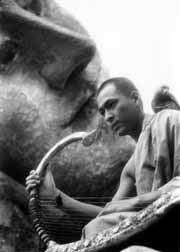
Since this is a relatively well known, and much discussed, Japanese film, I'm going to concentrate more on what's been written about it, and what I've found the most valuable or interesting. I'll start with a quote from Donald Richie and Joseph Anderson's The Japanese Film:
[The Harp of Burma] was based on a novel originally written to introduce children to certain Buddhist tenets, which was about a Japanese soldier's decision to remain in Burma after the war and not to return home with his unit so that he can become a mendicant priest, traveling about the country and tending to the unburied war dead.
Originally the film was to have been directed by Tomotaka Tasaka, who had made Japan's best war pictures, but because of his continuing illness the picture was given to Kon Ichikawa. In spite of the many various vicissitudes which the film underwent, including a hack editing job by Nikkatsu, the picture was thought good enough to win the 1956 San Giorgio Prize in Venice, an award given the film which best shows "men's capacity to live ane with another."
Richie mentioned Nikkatsu's "hack editing job", but the specifics of this are laid out in Tony Rayns' excellent essay included with the Criterion Collection DVD of the film:
Nikkatsu treated The Burmese Harp as what we would now call an “event movie” and released it in two parts, three weeks apart. Part one (running 63 minutes) opened on January 21, 1956, and part two (80 minutes) opened on February 12, both with B features. The total running time of 143 minutes was cut to the current 116 minutes when the two parts were combined for rerelease and export—reputedly to Ichikawa’s dissatisfaction.
Rayns doesn't mention that part one actually had a subtitle, called "Part 1, Nostalgia", or "Homesickness".
There's an illuminating exchange between Joan Mellen and Ichikawa in her Voices From the Japanese Cinema:
Mellen:Is there any similarity between your Private Mizushima in The Harp of Burma and Goichi of Conflagration?
Ichikawa: They represent the youth of Japan. In the case of Mizushima the time was the middle of the war, and with Goichi it was just after the war. In his sense both, whether a soldier or not, represent Japanese youth.
Mellen: What is the origin of their disillusionment with the world? Are they each disillusioned about the same things and could we define exactly what they are disillusioned about in a general way?...
Ichikawa: Both are very young and both are in search of something. Neither knows exactly what he is after, as they are still young. Both thrust themselves against the thick wall of reality and disillusionment trying to find out what they desire.
Mellen: As in the burning of the temple. What do they desire?
Ichikawa: Truth.
Mellen: Is it the truth of themselves or of the world?
Ichikawa: The truth of their own lives.
And a quote from Keiko McDonald's From Book To Screen: Modern Japanese Literature in Films sums up a general conclusion about the politics of the film:
Right from the start [Ichikawa] shows two different responses to defeat in the war. The singing company represents a new kind of soldier, one motivated by the individualism that will characterize postwar Japanese society. Accepting defeat as part of the human condition, they hope to survive confinement in a POW camp and work for the reconstruction of their country, each in his own way.
Another company is made up of old-style Japanese soldiers. Their values are traditional, collective. They feel a moral imperative to fight on to the bitter end, preferring a dutiful death to the shame of surviving defeat.
Mizushima's role is to bridge the two. His mission is to persuade the diehard traditional soldiers to adopt his company's strategy of accepting defeat and surviving it.
But what I really love is this quote from Sato Tadao about the art of the film, translated by Anne McKnight and included in Quandt's Kon Ichikawa volume:
Harp of Burma becomes the story of the soldiers who stay. Their interior lives are not depicted through exaggerated emotion, but inferred from the compositions. The positioning of characters within the landscape or against each other subtly guides the spectator's feeling-for example, by the way a figure dominates the image; bears down on another from the top of the screen; or approaches the centre of the composition. Ichikawa's skill with compositional layout renders the entire image extremely beautiful, to the point that it becomes a craft of good graphic design.
I found myself affected by the film more for it's use of imagery than as a reference for war guilt or postwar humanism. The many shots of Mizushima or his comrades emerging from the forest, covering his eyes at the sight of the dead, or scanning the barren countryside will linger for some time. I'm glad that the Criterion Collection finally got around to releasing this and Fires on the Plain on DVD, but I can't help but feel that Ichikawa's Enjo (AKA Conflagration) was ignored. It would have made a perfect pairing with the other two, and I feel a chance has been missed to get this film out there.
No comments:
Post a Comment